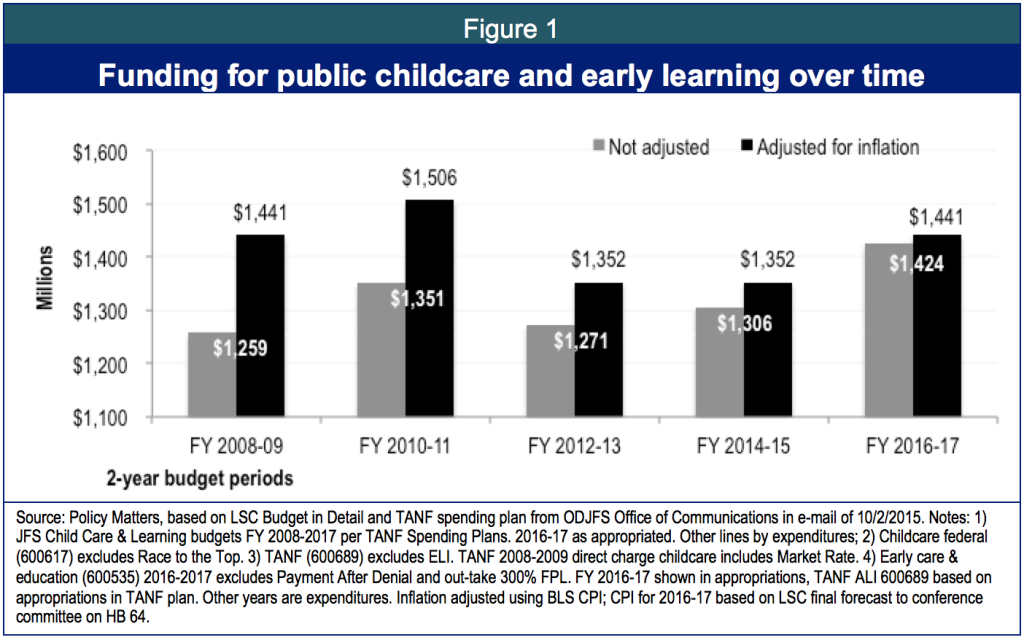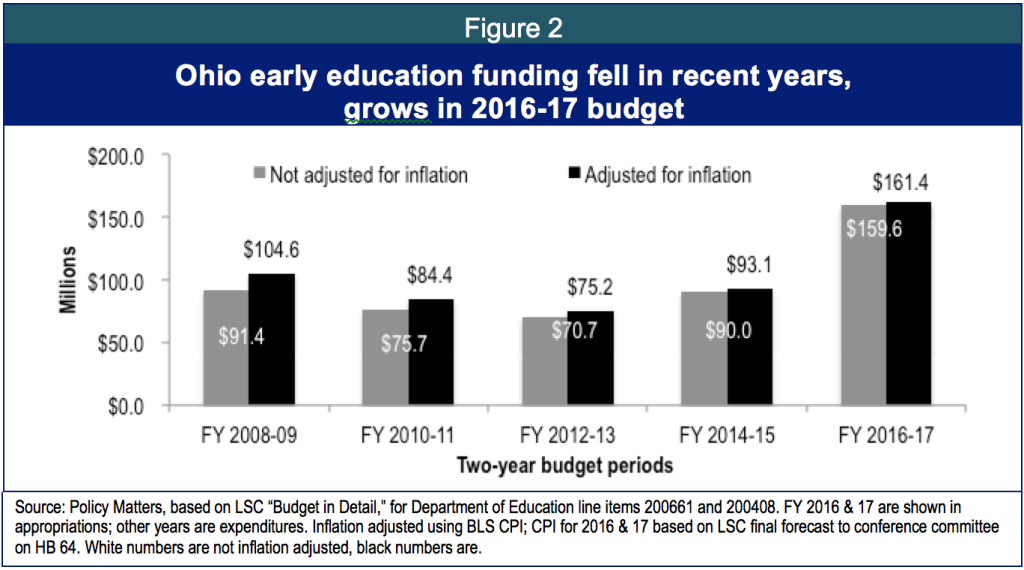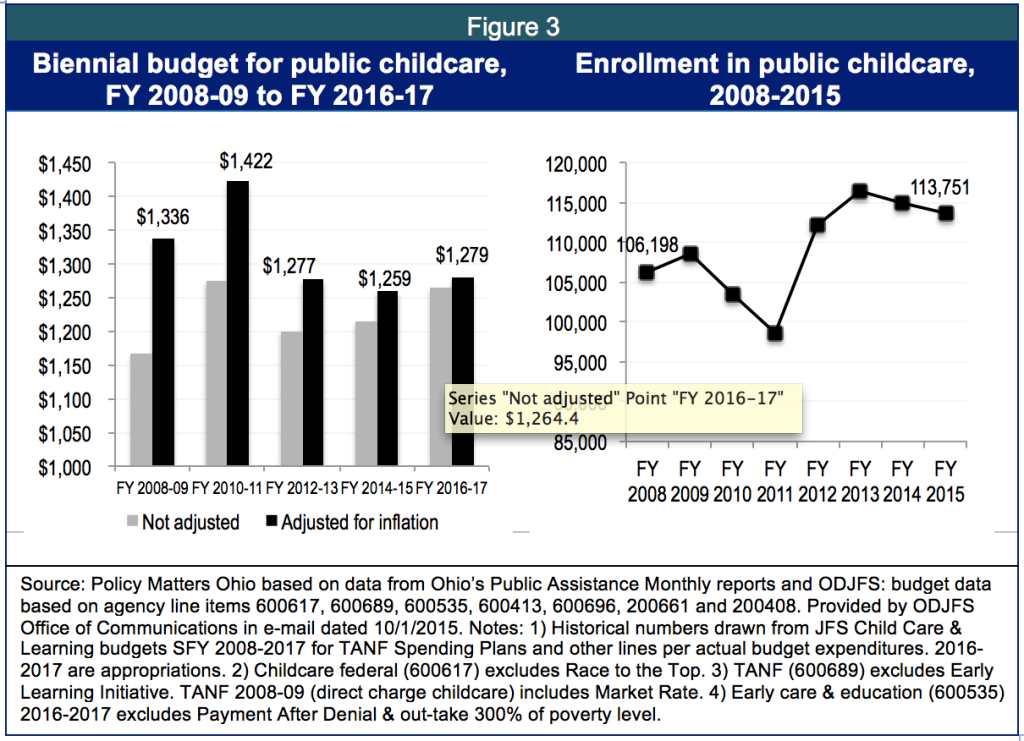
Improving how Ohio cares for kids
January 27, 2016
Improving how Ohio cares for kids
January 27, 2016
Contact: Wendy Patton, 614.221.4505
Executive summary
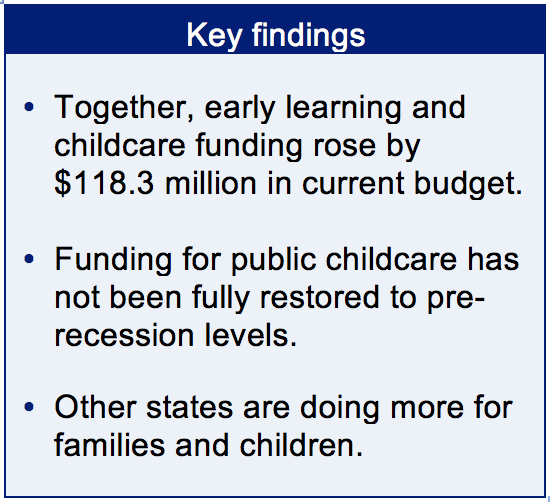 Children in Ohio are less likely to be in publicly funded preschool or childcare than in other states. This makes it hard for struggling parents to work and it means that children here are less likely to enter school ready to learn.
Children in Ohio are less likely to be in publicly funded preschool or childcare than in other states. This makes it hard for struggling parents to work and it means that children here are less likely to enter school ready to learn.Ohio spends less on these essentials than other states and funding has fallen from peak years. While the current budget boosted spending, far too many Ohio families can’t get the help they need.
The Department of Education’s early-learning program provides public pre-kindergarten for some children whose families have income less than 200 percent of the federal poverty level (about $40,000 for a family of three). Early education prepares children for success in school and work, which builds a strong, competitive workforce for the future. Between 2001-02 and 2013-14, Ohio’s pre-K enrollment plunged by more than 15,000 slots. Today, just 4 percent of Ohio’s low-income 4 year olds are enrolled, compared to a national average of 29 percent.
Public childcare is considered a work support or a human service because it helps struggling parents pay for childcare so they can work. Public childcare serves families with very low incomes. Initial eligibility is set at 130 percent of the federal poverty level (about $26,120 a year for a family of three). This was improved in the current budget, but most states help a much larger share of struggling families. In 2009, Ohio’s initial eligibility for childcare was 200 percent of poverty, so a larger share of families used to be able to get help. We need to get back to that level.
Ohio’s early-learning programs and public childcare programs are not aligned. Early learning programs are often part-time but working parents need full-time care. Eligibility levels are different. Children in early learning are accepted into a class for a year at a time (this is referred to as 12-month continuous eligibility), but public childcare moves children in and out of classrooms as parents’ jobs change or end.
For comprehensive alignment we must raise initial eligibility in public childcare to 200 percent of poverty and provide continuous, 12-month eligibility.
Introduction
Ohio is not investing enough in children, and as a result, children here are far less likely to be in publicly funded preschool or childcare than in other states. This makes it hard for struggling parents to work and it means that children are less likely to enter school ready to learn.Pre-kindergarten is critical to helping kids learn and setting them up for success in school and work. Yet in Ohio, just 4 percent of 4 year-olds from low-income families are enrolled in pre-school, compared with 29 percent nationally. Not only is Ohio behind most of the nation in pre-school and childcare support, differing eligibility standards between the two programs means many kids miss out on the opportunities. Some parents can’t send their kids to half-day preschool because they don’t qualify for childcare assistance for the other half day.
Between underinvestment and misalignment, Ohio is falling behind in developing the workforce of the future, which bodes ill for the state in a competitive global context.
The General Assembly made some important improvements in Ohio’s system of early learning and childcare in the new budget. They smoothed the childcare “cliff”: assistance will be tapered off more gradually as families earn more. Very poor families earning less than poverty wages will not have co-pays for childcare. Legislators slightly boosted the level of initial eligibility for childcare and added new funding to both childcare and early learning. However, there is a long way to go to ensure every eligible child has access to needed pre-school and working parents have safe and high-quality childcare.
Early learning and childcare in the 2016-17 budget
Ohio is still spending less on childcare and early learning than in the peak years over the past decade. Early learning and pre-kindergarten funding rose by $69.7 million in fiscal years 2016-17, a hefty 77.5 percent increase over the budget period of 2014-15. Public childcare blipped upward by $48.6 million, a 4 percent increase. Taken together, new investment in the current budget totals $118.3 million (not adjusted for inflation).
The trend is in the right direction, but funding for care and education of children in struggling families has not kept pace with inflation. In this budget, Ohio will spend almost what we did during the recession (2008-09) and less than we did during the budget for 2010-11 (Figure 1).
Ohio’s early care and education programs for children of low-income families are administered by different agencies and have different eligibility rules and tracking systems. Yet they should seamlessly serve the same population, preparing young children for success in school while helping parents succeed at work.
The Ohio Department of Job and Family Services administers the public childcare program. It is considered a work support, because without it, parents couldn’t afford to work in low-wage jobs. Public childcare is funded by the federal Child Care and Development Block Grant (CCDBG) and by the federal Temporary Aid for Needy Families (TANF) and its state matching funds. Funding will be about $1.3 billion over the two-year budget period for 2016 and 2017 (years are state fiscal years – which run from July 1 to June 30 each year – unless otherwise indicated). Early learning and education, by contrast, is a tiny Ohio Department of Education program , funded for 2016-17 at about $161 million.
Early learning and pre-K
The Department of Education’s early-learning program provides public pre-kindergarten for children whose families have income less than 200 percent of the federal poverty level (about $40,000 for a family of three). Though Ohio has boosted investment in early learning (Figure 2), it started from an eroded position. Even as far back as 2008-09, state early learning services had already shrunk compared to 2001-02.[1]
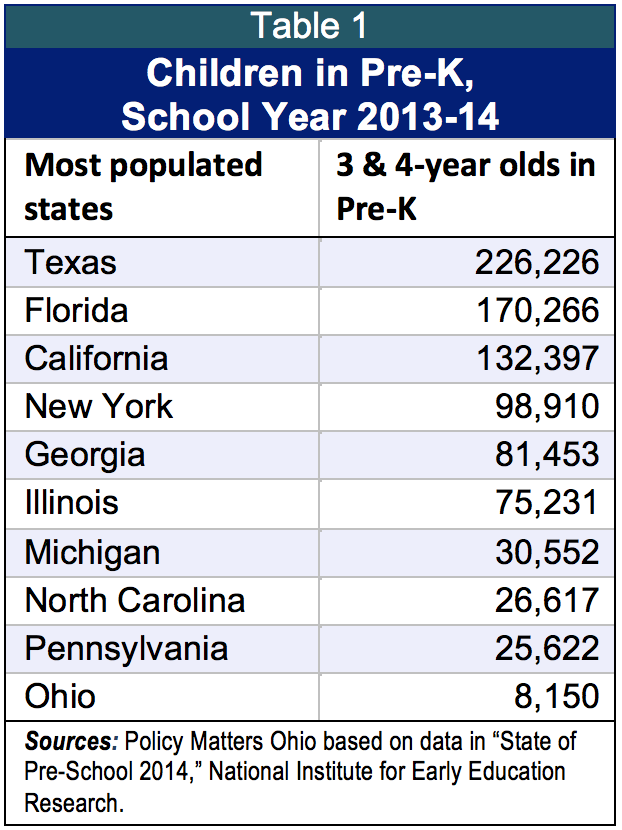 The National Institute for Early Education Research publishes an annual assessment of state investment in early learning and pre-kindergarten. In the most recent report, covering school year 2013-14, Ohio ranked 36th among states in pre-K access for 4-year olds and 21st for 3-year olds. Ohio spent $4,000 in state dollars per child (not including Head Start or special education). We ranked 21st in spending per child, below the national average of $4,125.[2]
The National Institute for Early Education Research publishes an annual assessment of state investment in early learning and pre-kindergarten. In the most recent report, covering school year 2013-14, Ohio ranked 36th among states in pre-K access for 4-year olds and 21st for 3-year olds. Ohio spent $4,000 in state dollars per child (not including Head Start or special education). We ranked 21st in spending per child, below the national average of $4,125.[2]
Between 2001-02 and 2013-14, Ohio’s pre-K enrollment dropped by 15,449 slots.[3] In school year 2014, just 2 percent of Ohio’s low-income 3-year olds were enrolled in pre-K. Just 4 percent of Ohio’s low-income 4 year-olds were enrolled, compared to a national average of 29 percent. As Table 1 shows, Ohio enrolled a fraction of the children enrolled in other populous states in 2013-14.[4]
Ohio’s legislature has increased funding since then. Spending for pre-K rose by $22 million in the two-year budget for 2014-15, boosting slots to 11,090. The 2016-17 budget increases slots to more than 17,000 – which would still leave us behind all other large states and far behind most of them..
Public childcare
Public childcare is considered a work support or a human service because it helps struggling parents pay for childcare so they can work. Ohio is serving more children but spending less than during the recession (Figure 3). This means quality has declined. If we ignore inflation, spending for public childcare in the current budget is 4 percent greater than during the last budget ($48.61 million).
Public childcare serves families with very low incomes. Initial eligibly is set at 130 percent of the federal poverty level (about $26,120 a year for a family of three). Most states help a much larger share of struggling families.
The administration says $28.61 million in the 2016-17 budget will support the following initiatives:[5]
- Elimination of childcare co-pays required of families earning less than the federal poverty level ($20,090 for a family of three).
- Smoothing out of the childcare cliff. Those who enter the program at the initial eligibility level will remain enrolled as income rises to about $60,000 for a family with two small kids. This is positive, but small. Because of the churning low-wage labor market and parents’ difficulty in remaining enrolled, few make it to the cliff. In 2014, less than 2 percent of program participants studied left because they earned too much money.[6]
- Initial eligibility for childcare aid will rise from 125 percent of poverty (about $25,112 a year for a parent with two kids) to 130 percent of poverty (about $26,117). This boosts Ohio’s ranking among the states from the third-lowest level of initial eligibility to about ninth – still in the bottom 10.[7] In 2009, Ohio’s initial eligibility for childcare was 200 percent of poverty.[8]
Ohio’s early learning programs and public childcare programs are not well aligned. Early learning programs are often part-time but working parents need full-time care. Eligibility levels are different: 200 percent of poverty for initial entry into early learning and 130 percent for public childcare. This means a parent who earns $30,000 and has two preschoolers is eligible for a morning preschool program, but not for childcare assistance to care for the kids in the afternoon. Further, children in early learning are accepted into a class for a year at a time, but public childcare moves children in and out of classrooms as parents’ jobs change or end.[9] The budget bill requires the Department of Education to synchronize early childhood education eligibility, application, tracking, and payments with the public childcare program of the Ohio Department of Job and Family Services.[10] But for comprehensive alignment, we must raise initial eligibility in public childcare to 200 percent of poverty and provide continuous, 12-month eligibility.
New federal block grant rules will help
The federal government has outlined possible new rules in conjunction with reauthorization of the federal block grant program that supports childcare. New rules would ensure all children who receive childcare through the block grant are eligible for a minimum of 12 months of assistance regardless of changes in parents’ employment or training participation, as long as family income does not exceed maximum eligibility.[11]
Summary and conclusion
A much smaller share of children in Ohio attend publicly funded pre-K or childcare than in other states. Funding for early care and education jumped in the 2016-17 budget, providing a significant increase in pre-K slots from a very low starting point. Yet funding across the system, which dropped in the years following the recession, is not yet restored to previous peaks. Pre-K enrollment has plunged since 2000. Public childcare serves more kids, but with less money, meaning quality has dropped. It’s much harder to qualify for help in Ohio than in other states. Ohio needs a long-term commitment to adequate funding for early learning and childcare, backed by the necessary state investment.
[1] By 2008-09, Ohio had fallen from 19th among the states in 2001-02 to 30th in share of low-income 4-yer olds enrolled in early learning, with a loss of almost 2000 slots for 4-year olds (about the same for 3-year olds as well.) National Institute for Early Education Research (NIEER), “State of Preschool 2014,” Rutgers University, at http://nieer.org/sites/nieer/files/Yearbook2014_full2_0.pdf
[2] NIEER, “State of Preschool 2014,” Rutgers University, at http://nieer.org/sites/nieer/files/Yearbook2014_full2_0.pdf
[3] Taken from the NIEER website (“State of Preschool Yearbooks) at http://nieer.org/yearbook
[4] NIEER, op.cit.
[5] Office of the Governor, Budget Fact Sheet at
http://governor.ohio.gov/Portals/0/pdf/budget/FY1617%20Budget%20Fact%20Sheets.pdf
[6] Policy Matters, “Ohio’s childcare cliffs, canyons and cracks,” at http://www.policymattersohio.org/childcare-may2014
[7] National Women’s Law Center, “Turning the Corner: Child Care Policies 2014,” Table 1B, at
http://www.nwlc.org/sites/default/files/pdfs/nwlc_2014statechildcareassistancereport-final.pdf
[8] GroundWorks, Early Childhood Investments in the 2008-09 Budget, at
http://groundworkohio.org/wp-content/uploads/2014/07/Report-on-2008-2009-Investments.pdf
[9] One time a year parents are given 3 months to replace a lost job or get a job if they graduate. However, if a second separation occurs within a 12-month period, the time is far shorter.
[10] LSC Greenbook for the Ohio Department of Job and Family Services, http://www.lsc.ohio.gov/fiscal/greenbooks131/jfs.pdf
[11] Jay Nichols, “Obama Administration Proposes New Childcare Regulations,” Child Aware of America, December 18, 2015 at http://usa.childcareaware.org/2015/12/obama-administration-proposes-new-child-care-regulations/
Tags
2016Budget PolicyChild careWendy PattonPhoto Gallery
1 of 22
